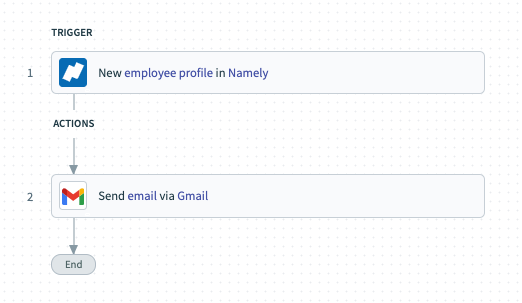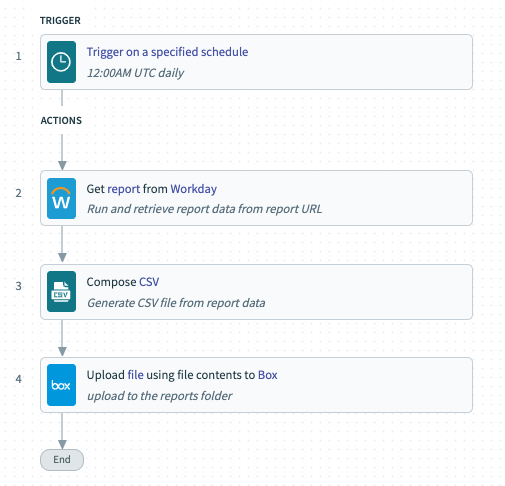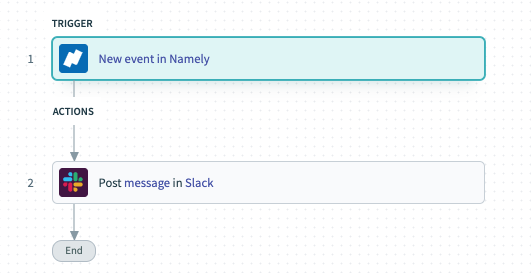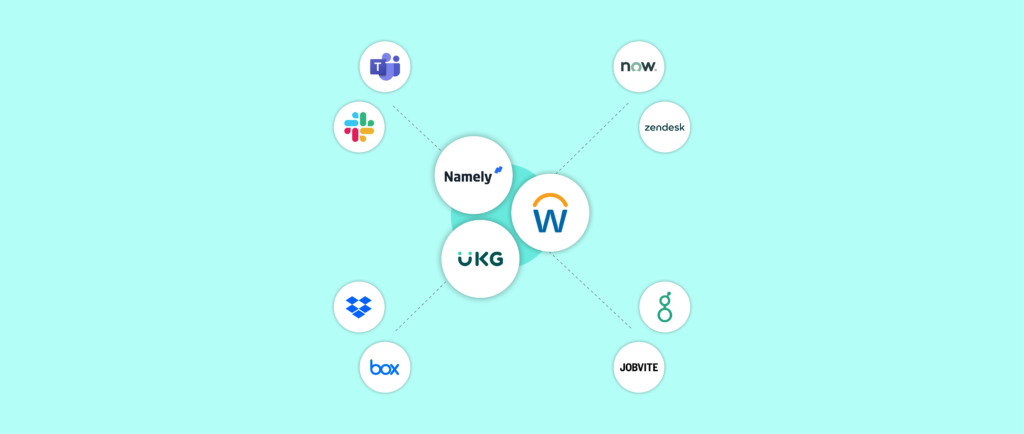Your human resources information system (HRIS) is incredibly versatile.
It helps you track job candidates, manage PTO requests, administer benefits, evaluate team members, build reports—and the list goes on.
And yet, as valuable as the platform is, it can’t do everything on its own. To execute all of your activities on behalf of candidates and employees effectively, you’ll need to integrate your HRIS with other apps.
We’ll break down why that is by covering several examples. We’ll also share some of your options for implementing the integration. That way, you’ll be able to decide how you integrate your HRIS with the rest of your tech stack and the tool you use to facilitate the process.
To get us started, let’s align on what we mean by HRIS integration.
Note: An HRIS is often used synonymously with HRMS, or a human resources management system, as well as HCM, or a human capital management application.

Integrate your HRIS with the rest of your tech stack with Workato
Learn how Workato, the leader in enterprise automation, can help you integrate your HRIS with other apps in a matter of minutes and without having to write a single line of code.
What is HRIS integration?
It’s the process of connecting your HRIS with other applications, typically via their application programming interfaces (APIs). Once connected, the apps can easily move data and keep any in sync.
Related: Common HR automations that use Microsoft Teams
Common HRIS integrations
With this definition in mind, let’s explore common integration use cases.
1. Kickstart employee onboarding immediately
Once a candidate signs their offer letter, you’ll want to move as quickly as you can to onboard them.
This involves provisioning them with access to the apps they need, procuring essential equipment and devices, scheduling meetings during their first week, etc.
To complete these tasks, you’ll likely need to create tickets in an ITSM tool. Only then can the appropriate colleagues become aware of the requests and work on fulfilling them before the new hire’s first day.
You can streamline this process by integrating an HRIS like Workday with an ITSM like ServiceNow and then implement a workflow that does the following: Once a candidate is marked as hired in Workday, a predefined set of onboarding tickets get created instantly in ServiceNow on behalf of the new hire.

These tickets can easily be modified or deleted, and additional tickets can always get added. But by creating a baseline of tickets automatically, hiring managers and employees in IT should save a substantial amount of time.
Note: In the example above, and in the others we’ll cover, you can swap the HRIS platform with whatever HR software you leverage at your organization, whether that’s BambooHR, ADP, Namely, etc.
2. Send employees an informative and warm introduction email on day 1
Your new hires likely have a variety of questions on their first day: How can they reach IT when they’re experiencing issues or have questions? What channels should they join within their business communications platform? What does their onboarding process entail?
A welcome email can help answer these questions, among countless others.
You can send this type of email to new hires on day 1 and customize its contents over time by integrating your HRIS with an email service provider and implementing the following:

1. Once a new hire gets added to your HRIS, the workflow gets triggered.
2. A customizable email gets sent to the new hire on their first day, allowing them to get many, if not all, of their questions answered proactively.
Popular Namely integrations
3. Provide employees with the data they need
Your HRIS likely has data that appeals to teams outside of HR—but that isn’t made readily accessible to them. To overcome this, regardless of context, you can integrate the system with a content management platform like Box. Once connected, specific reports can get added as CSV files in a specific folder (over a recurring, time-based cadence) within the content management platform.

Related: Integrations worth implementing with your applicant tracking system
4. Amplify important employee and company announcements
When noteworthy announcements are made, it’s crucial that the news reaches your employees immediately.
You can all but ensure that they do by connecting your HRIS with the business communications platform your employees work in, whether that’s Slack or Microsoft Teams. From there, you can set up a workflow where any time a specific announcement takes place in your HRIS (e.g. employee’s work anniversary), a templated message goes out in a specific channel within your business communications platform (e.g. #employee-announcements).

The event in an HRIS like Namely can easily be customized, as can the message that’s delivered in the business comms platform.
5. Assign trainings to maintain compliance and boost productivity
Training courses serve all kinds of purposes.
Some, such as courses on sexual harassment in the workplace, may be required by specific statutes; while others can provide invaluable learning and development opportunities for your team.
You can ensure that employees take both types of courses by integrating your learning management system (LMS) with your HRIS and then implementing the following: Based on the information provided in employee records (department, employment status, job level, etc.) within your HRIS, the LMS assigns an employee the appropriate set of courses. Moreover, as employees pass courses, that information gets fed back to their profiles in your HRIS—allowing HR to easily track their employees’ progress.
6. Create employee profiles for candidates as soon as they sign their offer letters
If you use an applicant tracking system (ATS) for recruitment and talent management, you’ll benefit from integrating the system with your HRIS for all sorts of reasons. For instance, once connected, you can implement a workflow where once the candidate is marked as hired in the ATS, their profile gets created automatically in your HRIS (using the information from the former to populate the fields in their account). Additional workflows can then get triggered, such as the first one we highlighted (creating tickets for onboarding tasks).
Benefits of HRIS integration
Here are just a few benefits to keep in mind:
- Data silos are removed. By allowing employees to access HRIS data within the platforms they’re already using, they don’t have to ask colleagues for it or be unaware that it exists.
- New hires can hit the ground running. Since the process of provisioning apps and procuring equipment for new hires is easier, new hires are more likely to get what they need to be productive on day 1.
- The employee experience improves. With data synced to and from your HRIS, employees can avoid extensive app hopping and data entry. They can use their newfound time savings to focus on more impactful and enjoyable tasks instead.
- Data quality is kept to a high standard. A common side effect of data entry is that it leaves employees prone to making mistakes, whether that’s forgetting to input employee data in one app or inputting the wrong data in another.
- Your HRIS becomes even more valuable. Once integrated with other apps, your HRIS can house additional insights on employees. In addition, (based on our examples and countless others) integrations can provide your HRIS with additional functionality, depending on the actions taken in the platform.
Options for integrating your HRIS
Once you’re set on integrating your HRIS with the rest of your HR systems (and with apps outside of HR), you’ve got a few options to choose from:
1. Implement point-to-point integrations.
Pros:
- Allows you to avoid relying on an external vendor
- Can effectively address your integration needs
Cons:
- Often time consuming to implement and maintain for developers
- Leaves your organization vulnerable when the select few developers who understand a point-to-point integration leave
- Extremely difficult to scale across your HR tech stack
- Doesn’t let you automate your HR processes
2. Use out-of-the-box connectors provided by the HRIS.
Pros:
- Often comes included with your subscription (or at a low additional cost)
- Can meet your integration requirements
Cons:
- Integration options only include those with the HRIS
- The connectors likely aren’t enhanced often or fixed quickly (when issues crop up) as the vendor’s dev team faces competing priorities
- Doesn’t let you automate your HR processes
3. Leverage an integration platform as a service (iPaaS).
Pros:
- Provides a single, centralized place to manage your integrations
- Meets a high standard of data security and protection (all but ensuring that your employee data is kept safe)
Cons:
- Requires technical expertise to use
- The process of implementing integrations can be lengthy as builders can take weeks, if not months, to implement any
- Doesn’t let you automate your HR processes
There’s a 4th option that can not only integrate your HRIS with the rest of your tech stack, but also automate workflows across your apps, data, and teams—an enterprise automation platform.
This platform provides the following, and much more:
- A low-code UX that enables lines of business to implement powerful integrations and automations in a secure, governed environment
- Pre-built connectors and automation templates that allow builders to move quickly
- A built-in bot framework that empowers employees to access data and take actions across their apps without leaving their business communications platform

Want to learn more about this type of platform?
Schedule a demo with an automation expert at Workato, the leader in enterprise automation.
